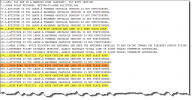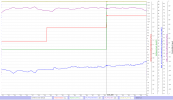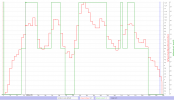As already said ... not much is constant for very long when flying drones
Yet... that is the whole point of what I said.
If winds, the major change, you are updated at a RTH battery level.
As already said ... not much is constant for very long when flying drones
That's about all it is.Or maybe the "high wind alert" is just a measure of tilt of the drone?
The drone won't keep flying until the battery runs out.Perhaps a parachute which deploys in the event of total battery drain resulting in loss of control that deploys to save your drone would be a potential upgrade just like some small airplanes have?
Thank you. Nice stiletto pattern btw. Looks like the boot of Italy. So if I hovered the drone instead of flying it around for the same amount of time that I could observe the drone altitude indication going up and down in hover? Interesting but I'm not going to do that just to find out. If I move my smart controller up/down in elevation by driving around in hilly terrain while flying the drone will that cause the drone altitude indication to change if the drone is hovering? I assume not but I'm also not going to try that either for now. I'll report back if I do with results.Are you assuming that people always make straight line flights out and back?
How would you calculate for winds that are at an angle to the flight path?
Here's a flight I did last week that involved significant winds.

How simple would it be to program the drone to keep track of the wind data for a flight like this and calculate how the return would be affected by wind?
It's a lot easier for it to calculate RTH battery requirements based on distance (and probably a small safety factor) and leave the flyer to do the extra calculating for anything more than a simple still air flight.
If you are saying that you've observed the indicated height on screen drift over the time of a flight, that's common and normal with a barometric sensor used to measure height.
GPS is not used to establish altitude, and hovering won't make any difference.
Oh, I thought you could override the auto land? Thanks.That's about all it is.
If the software calculates a wind speed of>7 metres/sec (15.5 mph, from a combination of the drone's speed, tilt and roll data, you get that warning.
The drone won't keep flying until the battery runs out.
On the battery reaching Critical Low Voltage, the drone enters autolanding to prevent a fall-from-the-sky incident.
That has a similar effect to a parachute, without the cost or weight penalty.
Just look at some of your flight records from past flights.So if I hovered the drone instead of flying it around for the same amount of time that I could observe the drone altitude indication going up and down in hover? Interesting but I'm not going to do that just to find out.
The height you see on the screen is the height of the drone relative to where it was launched.If I move my smart controller up/down in elevation by driving around in hilly terrain while flying the drone will that cause the drone altitude indication to change if the drone is hovering?
Dug down a bit in one of my own Mavic Air 1 DAT logs to see what I could find regarding wind warning triggers & what happens around the time for those warnings.... The drone MP2 does obviously know the wind speed at all times since on windy days it warns me with "High Wind Warning".




I do recommend attaching an Air TagMaybe you should post a reward for it? Possibly a gopher carried it away? Maybe think about putting some strobes on it for your next drone making it easier to spot especially in low light? Strobes have a long battery life and are easily visible.
We use essential cookies to make this site work, and optional cookies to enhance your experience.

